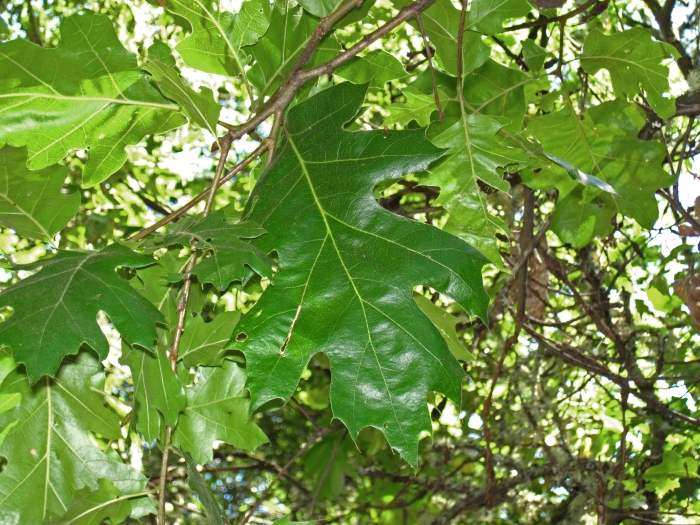California Black Oak
(Quercus kelloggii)
California Black Oak (Quercus kelloggii)
/
/

James St. John
CC BY 2.0
Image By:
James St. John
Recorded By:
Copyright:
CC BY 2.0
Copyright Notice:
Photo by: James St. John | License Type: CC BY 2.0 | License URL: https://creativecommons.org/licenses/by/2.0 | Uploader: Ser Amantio di Nicolao | Publisher: Wikimedia Commons | Title: Quercus_kelloggii_(California_black_oak)_(near_Calistoga,_California,_USA)_3_(49092853058).jpg | Notes: Transferred from Flickr via [[Commons:Flickr2Commons|Flickr2Commons]] |




































































Estimated Native Range
Summary
Quercus kelloggii, commonly known as California Black Oak or Kellogg Oak, is a deciduous tree native to the mixed coniferous forests, oak woodlands, and lower montane regions of California and southwestern Oregon. It can grow to a height of 30-82 feet (9-25 meters) and a width of 15-30 feet (4.5-9 meters). The California Black Oak is characterized by its deeply lobed leaves, dark gray to black bark, and yellow to orange-yellow fall foliage. It produces acorns that are a valuable food source for local wildlife. The tree’s flowers are catkins, which are not particularly showy, but its strong structure and attractive bark make it a notable presence in the landscape.
This oak is appreciated for its adaptability to different soil types, though it prefers well-drained soils. It is drought-tolerant once established, making it suitable for water-conserving gardens and sustainable landscapes. It is used in restoration projects and as an ornamental tree in parks and large gardens. While it is generally low-maintenance, it can be susceptible to sudden oak death and oak root fungus. It is also important to note that the acorns and leaves can be toxic to livestock if ingested in large quantities.CC BY-SA 4.0
This oak is appreciated for its adaptability to different soil types, though it prefers well-drained soils. It is drought-tolerant once established, making it suitable for water-conserving gardens and sustainable landscapes. It is used in restoration projects and as an ornamental tree in parks and large gardens. While it is generally low-maintenance, it can be susceptible to sudden oak death and oak root fungus. It is also important to note that the acorns and leaves can be toxic to livestock if ingested in large quantities.CC BY-SA 4.0
Plant Description
- Plant Type: Tree
- Height: 30-82 feet
- Width: 15-30 feet
- Growth Rate: Slow
- Flower Color: N/A
- Flowering Season: Spring
- Leaf Retention: Deciduous
Growth Requirements
- Sun: Full Sun, Part Shade
- Water: Medium
- Drainage: Fast, Medium
Common Uses
Bee Garden, Bird Garden, Butterfly Garden, Drought Tolerant, Edible*Disclaimer: Easyscape's listed plant edibility is for informational use. Always verify the safety and proper identification of any plant before consumption., Low Maintenance, Rabbit Resistant
Natural Habitat
Mixed coniferous forests, oak woodlands, and lower montane regions of California and southwestern Oregon
Other Names
Common Names: Kellogg Oak
Scientific Names: Quercus kelloggii , Quercus californica , Quercus tinctoria var. californica , Quercus sonomensis
GBIF Accepted Name: Quercus kelloggii Newb.